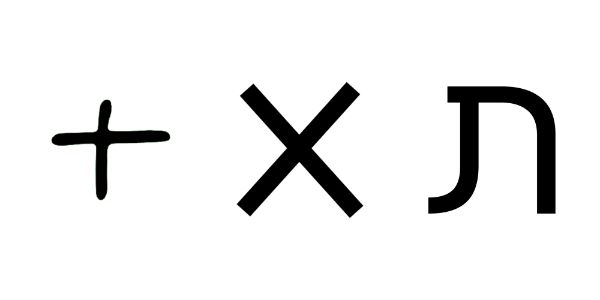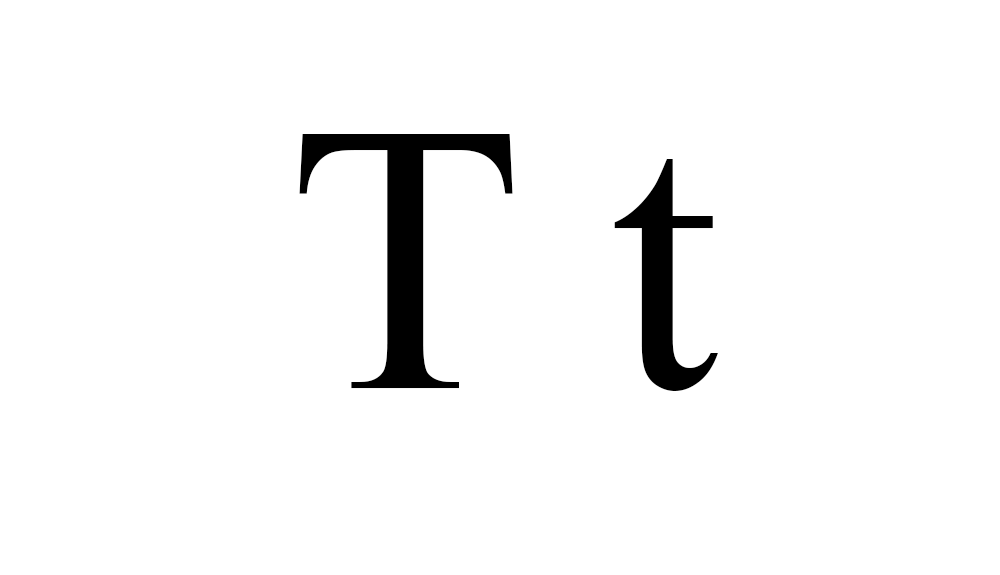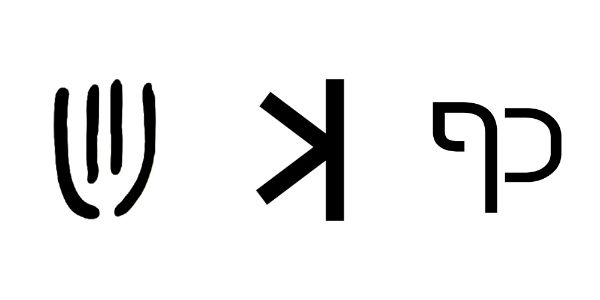Acceptable ways to write it: tau (tu)
The letter tau (𐤕) or T/t is the twenty-second letter in the Afroasiatic language known as Paleo-Hebrew (Ābarayat). The letter has been equated with the letter T, the letter Th, and the letter X in the English language. Nonetheless, the letter T is the more accurate letter but possibly had a similar pronunciation to that of X in earlier days or could entirely be attributed to the similarity in looks between the two letters. However, it should not be confused with the letter thanaa (𐤈) in the Paleo-Hebrew language, which holds a Th equivalent.
The Paleo-Hebrew language or the original language of the Ābarayam is one spoken with an emphasis on the rauakh (breath, wind, spirit). With the language of the Ābarayam, each letter has a meaning and a number associated with it that adds meaning to each word they’re used with. Below you will be able to learn more about the letter in Ancient Hebrew, Yiddish Hebrew, Greek, and much more.
Letter Meanings
| Letter | Meaning |
|---|---|
| 𐤕 (t) – ta | mark, sign, covenant, signature, identification of people, places, or things |
| Prefix | Not applicable |
| Suffix | turns a word into the feminine counterpart of a masculine word. signifies a language when preceded by 𐤉 (yad). |
| Number | 400 |
Based on the meaning of the letters the word could be defined as:
- “mark of…”
- “sign of…”
- “covenant of…”
- “place of…”
- “language of…”
Definitions for 𐤕 / t
| Language | Word | Transliteration | Pronunciation | Definition |
|---|---|---|---|---|
| Ābarayat | 𐤕 | t | ta | head and person, man, beginning, top, rule, inheritance, possession |
| English | T t | t | /ˈtiː/ | the twentieth letter and the sixteenth consonant of the modern English alphabet. |
| Hebrew | ת | t | /t/ | mark, sign |
| Arabic | ت | t | /t/ | time, following / retrospective |
| Greek | Τ τ / ϛ / Χ χ | t | [t] | tau: the nineteenth letter of the Greek alpha-beta |
Images for 𐤕 / t


History of Meaning
The pictograph of the word is of a mark or sign resembling an “X” or a cross “+” tilted to the side, also of a covenant, the mark of the covenant. So it is the picture of two crossed sticks is a mark such as a “target” one aims at when shooting. The original picture is a type of “mark,” probably of two sticks crossed to mark a place, similar to the Egyptian hieroglyph, a picture of two crossed sticks. This letter has the meanings of “mark,” “sign” and “signature.”
History of the Letter T
The letter T was introduced in 700 BCE (3225 AM). “T” in its modern, lower-case form, is found all over ancient Semitic inscriptions. The Greeks named it “tau” and added a cross stroke at the top to differentiate it from “X.” In English, it is most commonly used to represent the voiceless alveolar plosive, a sound it also denotes in the International Phonetic Alphabet. It is the most commonly used consonant and the second most common letter in English-language texts.
The sound value of Semitic Taw, Greek alphabet Tαυ (Tau), Old Italic, and Latin T has remained fairly constant, representing [t] in each of these; and it has also kept its original basic shape in most of these alphabets.
Research Note
We believe that between the transitions from Ābarayat to Greek to Roman/Latin to English that the true equivalent may have been mixed with the Ābarayat tau (𐤕)’s “t” as most Modern Hebrew words use “t”. We are still researching to find a definitive answer.
History of the Letter X
The visual appearance of the letter X was introduced in 800 BCE (3125 AM). The ancient Greeks had a letter “ksi” which sounded like our “X.” Lower case “x’s” arrives via handwritten manuscripts of early medieval times and the Italian printing presses of the late 15th century.
In Ancient Greek, ‘Χ’ and ‘Ψ’ were among several variants of the same letter, used originally for /kʰ/ and later, in western areas such as Arcadia, as a simplification of the digraph ‘ΧΣ’ for /ks/. In the end, more conservative eastern forms became the standard of Classical Greek, and thus ‘Χ’ (Chi) stood for /kʰ/.
However, the Etruscans had taken over ‘Χ’ from western Greek, and it, therefore, stands for /ks/ in Etruscan and Latin. The letter ‘Χ’ ~ ‘Ψ’ for /kʰ/ was a Greek addition to the alphabet, placed after the Semitic letters along with phi ‘Φ’ for /pʰ/.
Definitions for 𐤕𐤉 / tay
When adding the 𐤉 (yad) to the end of a word, it creates a possessive of the original word. It can either signify “my…” or identify a member of a nation. For example, 𐤏𐤁𐤓 (Ābar) is the progenitor, but 𐤏𐤁𐤓𐤉 (Ābaray) is the singular descendant of him also known as a Hebrew.
| Language | Word | Transliteration | Pronunciation | Definition |
|---|---|---|---|---|
| Ābarayat | 𐤕𐤉 | tay | tey | |
| English | ||||
| Hebrew | ||||
| Arabic | ||||
| Greek |
Images for 𐤕𐤉 / tay


Definitions for 𐤕𐤉𐤌 / tayam
When adding the 𐤌 (mayam) after the 𐤉 (yad) to the end of a word, it creates a plural of the original word. It can identify multiple members of a nation. For example, 𐤏𐤁𐤓 (Ābar) is the progenitor, but 𐤏𐤁𐤓𐤉𐤌 (Ābarayam) are the plural descendants of him also known as Hebrews.
| Language | Word | Transliteration | Pronunciation | Definition |
|---|---|---|---|---|
| Ābarayat | 𐤕𐤉𐤌 | tayam | taw-yawm | |
| English | ||||
| Hebrew | ||||
| Arabic | ||||
| Greek |
Images for 𐤕𐤉𐤌 / tayam


Definitions for 𐤕𐤉𐤕 / tayat
When adding the 𐤕 (tau) after the 𐤉 (yad) to the end of a word, it creates a plural of the original word. It identifies the language or a sign of a nation’s existence. For example, 𐤏𐤁𐤓 (Ābar) is the progenitor, but 𐤏𐤁𐤓𐤉𐤕 (Ābarayat) is the language of him also known as Paleo-Hebrew language.
| Language | Word | Transliteration | Pronunciation | Definition |
|---|---|---|---|---|
| Ābarayat | 𐤕𐤉𐤕 | tayat | taw-yawt | |
| English | ||||
| Hebrew | ||||
| Arabic | ||||
| Greek |
Images for 𐤕𐤉𐤕 / tayat


Classification
You can continue your studies of the words by viewing Strong’s entries for:



